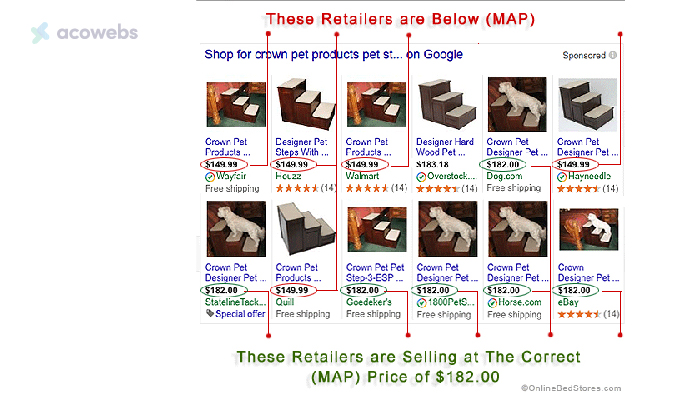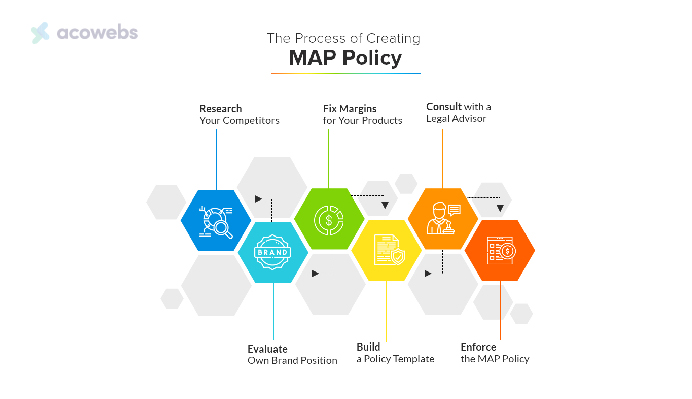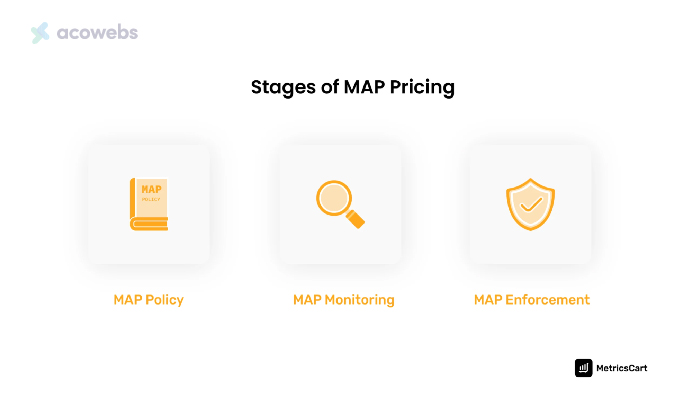Table of Contents
Competition is the foundation of commerce. It promotes innovation and benefits customers. The Minimum Advertised Price (MAP) is a fundamental notion in competitive retail operations. The lowest price at which retailers are permitted to list a manufacturer’s product for sale is determined by MAP.
Navigating the complexity of retail tactics requires an understanding of the intricacies of MAP pricing strategy. This article provides a thorough analysis of MAP pricing, exploring its workings, ramifications, and influence on retail competition.
It seeks to bring producers, retailers, and customers alike clarity by explaining the basic ideas of MAP and delving into its practical nuances.
MAP pricing is a crucial component of modern retail strategy since it influences market dynamics and protects brand integrity.
What Is the Minimum Advertised Price
The Minimum Advertised Price is a pricing strategy implemented by brands or manufacturers to control the lowest price at which merchants are permitted to list their goods for sale.
The price that can be shown in advertisements or online listings is expressly governed by MAP, as opposed to the real selling price in-store.

In the example above, Wayfair, Houzz, Hayneedle, and Quill are all violating the manufacturer’s “Crown Pet Products” (MAP) policy.
In essence, MAP helps to preserve brand value and pricing integrity by acting as a buffer against price erosion.
MAP policies are commonplace in many different industries and product categories globally, and each company or brand usually has its own set of regulations. The policies have been carefully designed to align with the brand’s competitive strategy and market positioning.
Manufacturers prioritize MAP policy enforcement because infractions can damage brand impression and upset the balance of the market. Retailers that abide by MAP are shielded from pricing conflicts resulting from excessive discounting and are guaranteed fair competition.
While MAP promotes fair competition among retailers, it also gives manufacturers authority over the perception of their brand and value in the marketplace.
The Mechanics of MAP Pricing
Manufacturers or brands set the rules for MAP pricing, which determines the lowest price at which merchants can advertise their goods. This is how it operates:
1. Policy Formulation
In the context of minimum advertised pricing policy design, manufacturers go through a rigorous procedure to create standards that specify the lowest prices that can be displayed for their products.

These regulations are carefully crafted to complement the brand’s overall marketing goals and strategy. First, manufacturers look at how their brand is positioned in the market, taking into account aspects like product attributes, quality, and reputation.
This evaluation assists in ascertaining the perceived worth of their products in comparison to rivals and provides guidance for the development of the MAP policy to maintain this positioning.
Additionally, when designing MAP policies, manufacturers consider the inclinations and shopping habits of the target market.
For example, mass-market firms may use more flexible pricing methods to appeal to a wider audience, whereas luxury brands may set higher minimum costs to maintain exclusivity.
In order to discover pricing trends, navigate competitive pressures, and evaluate the pricing tactics of competitors and merchants within the same product category, producers must conduct competitive analysis.
Legal concerns are also crucial since they guarantee adherence to pertinent laws and rules, preventing anti-competitive behavior. Manufacturers hope to preserve brand value, uphold pricing integrity, and promote healthy competition in the retail space by incorporating these elements.
2. Retailer Compliance
Retailers must adhere to MAP rules in order to guarantee pricing integrity and protect the manufacturer’s brand. The lowest price at which retailers are permitted to advertise a product, regardless of its actual in-store selling price, is determined by the Minimum Advertised Price standards.
Consider the following situation: A product’s producer establishes a $50 MAP. This means that even if they intend to sell it for, say, $45 in-store, retailers cannot advertise it for less than $50.
The goal is to keep pricing consistent and transparent so that consumers aren’t duped by ads that appear to be offering absurdly low costs.
Retailers need to be sure they are following MAP regulations. Ads, marketing, and internet listings may need to be changed to comply with the manufacturer’s required price floor.
MAP policy noncompliance, however, has repercussions. Retailers run the possibility of fines including distribution agreement termination, privilege loss, and reputational harm.
As a result, abiding by MAP regulations involves more than just following instructions; it also entails long-term protection of their reputation and commercial interests.
3. Monitoring and Enforcement
Sustaining price integrity and protecting brand value necessitates close monitoring and enforcement of MAP regulations. Manufacturers use a range of tactics, such as using price tracking software to keep an eye on online retail channels and auditing and analyzing the market to assess retailer compliance.
Price tracking software, like the Competitors app, might be used by a consumer electronics firm enforcing a minimum advertised price (MAP) policy for its flagship smartphone to find merchants advertising below the MAP.

The producer then sends out cease and desist letters and may penalize or restrict the amount of merchandise allotted to repeat violators. The manufacturers’ dedication to maintaining price standards and safeguarding the brand name is demonstrated by these watchful actions.
4. Penalties for Non-Compliance
Penalties for breaking MAP regulations act as a disincentive to retailers undermining manufacturers’ minimum advertised costs.
In order to maintain pricing integrity and protect brand value, manufacturers may additionally enforce various consequences on retailers found to be in breach of MAP policies.
These consequences include:
- Loss of Privileges: Manufacturers may revoke certain privileges granted to non-compliant outlets, including the right of entry to one-of-a-kind promotions, marketing aid, or early product releases.
This lack of privileges targets to incentivize shops to conform to MAP suggestions and discourage destiny violations.
- Termination of Distribution Agreements: In instances of repeated or extreme MAP violations, producers may opt to terminate distribution agreements with non-compliant stores.
This motion not only sends a clear message regarding the seriousness of MAP compliance but also permits manufacturers to preserve control over distribution channels and uphold pricing requirements.
- Reduction in Product Allocations: Manufacturers might also lessen the allocation of merchandise to non-compliant outlets as a form of penalty. By limiting the supply of merchandise to stores that continually violate MAP policies, producers can mitigate the poor effect of undercutting prices on brand perception and profitability.
- Legal Action: In extreme cases of non-compliance or blatant brush aside for MAP regulations, manufacturers may additionally pursue prison movement in opposition to offending stores. Legal remedies may include searching for damages for breach of agreement or acquiring injunctions to put in force compliance with MAP tips.
5. Consumer Perception
MAP pricing strategy plays a vital role in shaping purchaser notions by fostering a constant pricing method throughout various retail channels. When manufacturers implement MAP policies, they set a baseline fee under which stores aren’t allowed to market their products.
This consistency in pricing creates a sense of fairness and reliability for customers, as they are able to anticipate paying a comparable rate for a product regardless of where they shop.
Furthermore, manufacturers can effectively convey to customers the worth of their products by upholding consistent prices through MAP regulations. When fees continue to be regular, consumers understand the product as having a regular high-quality and value proposition, which in flip builds trust within the brand.
This trust is important for fostering loyalty among purchasers, as they are more likely to repurchase from an emblem that continuously supplies its guarantees. Additionally, the MAP pricing strategy helps prevent price wars and immoderate discounting amongst retailers, which may dilute the perceived price of a product.
When fees are artificially lowered, customers can also query the first-rate or authenticity of the product, leading to a decline in logo belief.
By putting a minimum advertised price, producers ensure that their products aren’t devalued in the eyes of consumers, consequently maintaining logo equity and maintaining a top-class photo in the marketplace.
Benefits of MAP Pricing Strategy
1. Maintaining Brand Image
A number of critical components go into preserving brand image when using Minimum Advertised Price (MAP) pricing.
- MAP protects the perceived worth of goods by stopping frequent discounts, which could lower consumers’ perceptions of their quality.
- It upholds the premium image of brands, making sure that their reputation for providing high-quality goods is not damaged by sales discounts.
- Establishing a minimum price threshold protects brand equity by demonstrating to customers the brand’s dedication to quality and value.
- MAP pricing encourages long-term sustainability by keeping businesses from being identified just with sales, drawing in more devoted clients who place a higher value on quality than quantity.
2. Fair Competition
MAP pricing sets a minimum price for products at which retailers must compete fairly with one another. This stops retailers from aggressively undercutting their competitors or starting price wars in which they repeatedly slash prices in an attempt to obtain a competitive advantage.
Without MAP pricing, retailers may turn to arbitrarily lowering costs in an attempt to draw in customers. This could result in a race to the bottom that could eventually be detrimental to both the reputation of the brand and the retailers.
With MAP pricing in place, businesses now compete on non-price-related criteria, including product selection, customer service, and exclusive value-added services.
As a result, the playing field is leveled, and businesses may set themselves apart by features that improve the overall buying experience as opposed to pursuing a downward cycle of price reduction.
This ultimately leads to a healthier and more sustainable retail ecosystem by giving consumers access to a more competitive and diverse marketplace where they can base their selections on factors other than price.
3. Protecting Margins
MAP pricing is an essential tool for safeguarding manufacturers’ and retailers’ profit margins. Setting a minimum price helps manufacturers protect their goods from being undervalued by merchants who over-discount them.
Maintaining profitability is especially dependent on this since products sold for less than a specific price may not generate enough revenue to cover production costs, which could lead to lower margins or even losses.
Manufacturers can keep control over the pricing of their goods and make sure that they are sold at a price that both reflects their worth and pays for related costs by sticking to MAP pricing.
By keeping merchants from participating in price wars or undercutting rivals to the point where profitability is jeopardized, MAP pricing encourages businesses to keep strong margins.
While retailers can be initially inclined to cut prices in order to draw in customers, doing so might ultimately result in poorer profitability, particularly if it spreads throughout the sector.
Retailers can compete on non-price variables like customer service, product range, or unique products without losing money by following MAP pricing.
4. Channel Control
MAP is used as a channel control tactic to govern how retailers sell their products.
Manufacturers want to preserve pricing uniformity across channels. Therefore, they set a minimum price at which retailers can offer their items. This preserves the brand’s perceived value and image while halting price erosion.
By enforcing the MAP pricing strategy, manufacturers effectively prevent retailers from engaging in price wars where they undercut one another, devaluing the product and hurting profit margins.
Furthermore, it dissuades retailers from using strategies like flash sales or deep discounts, which may draw people initially but may harm the brand’s reputation or cause it to lose its place in the market.
Manufacturers can guarantee that their products are offered through legitimate channels, like respectable distributors or retailers, as opposed to unapproved or dubious sources, by keeping control over price. This helps preserve the brand’s integrity and offers customers a dependable purchasing experience regardless of whether they buy the product online or in person.
Challenges of MAP Pricing
1. Enforcement
One of the primary challenges of MAP pricing is enforcement. It may be tough for manufacturers to reveal and put in force compliance with MAP policies, especially in the age of e-trade, where costs can differ hastily throughout distinctive systems.
2. Reseller Resistance
Some shops might also withstand MAP pricing regulations, viewing them as an infringement on their capability to set costs independently. This resistance can lead to conflicts between producers and retailers, probably damaging relationships.
3. Consumer Perception
While MAP pricing can help keep a brand’s image, it could additionally lead to purchaser perception troubles if customers understand merchandise as overpriced. Consumers may also be trying to find opportunity manufacturers or channels wherein expenses are lower, probably leading to misplaced income.
14. Legal Concerns
MAP pricing policies ought to comply with antitrust legal guidelines and policies to avoid accusations of charge-fixing or anti-competitive behavior. Navigating those legal considerations adds complexity to enforcing and implementing MAP pricing strategies.
Strategies for MAP Enforcement

The utilization of Minimum Advertised Price strategies is essential to maintain brand integrity and ensure fair competition among vendors. Here are a few powerful strategies to use MAP:
1. Clear communication
Start by actually copying the MAP code from all authorized stores. Provide accurate documentation describing the terms and conditions of the MAP settlement, including the consequences of the breach.
This ensures that each party assumes their responsibilities and the consequences of non-compliance.
2. Monitoring and Tracking
To track MAP compliance, a strong monitoring system must be put in place. This entails scanning offline and internet channels for any deviations from the near MAP values using electronic instruments and software.
Pricing reports for physical retail stores, online marketplaces, and eCommerce platforms should be produced in a variety of formats. This all-encompassing strategy guarantees careful observation and permits prompt action to properly handle any infractions.
3. Prompt Reporting
Reporting MAP infractions promptly is essential. Notifying the offending stores as soon as possible and providing proof (screenshots, inventory records, etc.) that the market value is less than the authorized MAP is important.
This paperwork guarantees openness and expedites the issue’s prompt settlement. For example, a merchant would be notified right away and provided with proof of the infraction if they advertised a product at a price lower than the manufacturer’s stated MAP.
4. Warning system
First-time offenders are given preventative measures through the implementation of a warning system, which enables them to correct MAP infractions in accordance with policy coverage.
Severe penalties, like the suspension of the seller’s sales authorization, could be imposed for repeat offenses. For example, a merchant may lose their authority to sell a certain product if they consistently market it below the MAP.
Conclusion
The Minimum Advertised Price (MAP) policy is a crucial tool in today’s retail industry, offering a framework for preserving brand integrity, fostering fair competition, and safeguarding profits. By establishing minimum prices for advertising, manufacturers can regulate how their products are presented to customers.
MAP pricing not only helps shape consumer perceptions by creating a sense of fairness and credibility but also helps communicate the value proposition, build trust and loyalty among consumers, and acts as a deterrent against price wars and excessive discounting
While MAP pricing offers many advantages, it also presents challenges, particularly in terms of regulatory enforcement, vendor resistance, customer perceptions, and legal concerns.
If clear communication, monitoring, and follow-up, with an early reporting and warning system in place, manufacturers can mitigate these challenges and maintain the integrity of their pricing processes.
Acowebs are the developers of the WooCommerce PDF Invoices and Packing Slips which generate PDF invoices automatically and add them to the confirmation emails sent to your customers.WooCommerce invoice plugin allow you Create, edit, and modify your own templates and to download or print invoices and packing slips from the WooCommerce admin.











 Login
Login
 Cart
Cart








